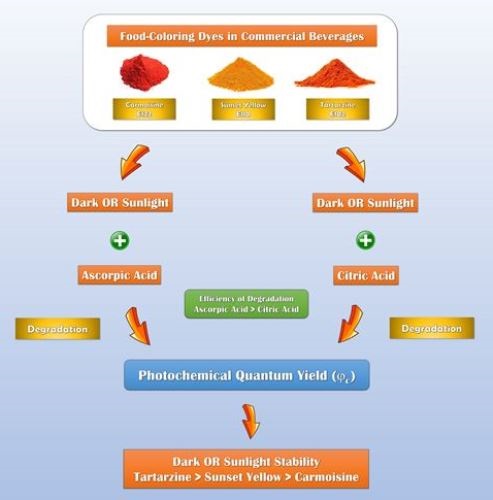
Photochemical and Thermal Stability of Carmoisine, Sunset Yellow and Tartrazine Food-Coloring Dyes in Commercial Beverages
Abstract
Full Text:
PDFReferences
R. Sharafati Chaleshtori and F. Golsorkhi, Determination of synthetic colors in some locally available foods of Kashan city, Iran, International Archives of Health Sciences, 2016, 3, 61-66.
K. S. Minioti, C. F. Sakellariou and N. S. Thomaidis, Determination of 13 synthetic food colorants in water-soluble foods by reversed-phase high-performance liquid chromatography coupled with diode-array detector, Analytica Chimica Acta, 2007, 583, 103-110.
A. I. Palianskikh, S. I. Sychik, S. M. Leschev, Y. M. Pliashak, T. A. Fiodarava and L. L. Belyshava, Development and validation of the HPLC-DAD method for the quantification of 16 synthetic dyes in various foods and the use of liquid anion exchange extraction for qualitative expression determination, Food Chemistry, 2022, 369, 130947.
P. M. Nowak, Simultaneous quantification of food colorants and preservatives in sports drinks by the high performance liquid chromatography and capillary electrophoresis methods evaluated using the red-green-blue model, Journal of Chromatography A, 2020, 1620, 460976.
H.-J. Jung, Y. S. Song, K. Kim, C.-J. Lim and E.-H. Park, Assessment of the anti-angiogenic, anti-inflammatory and antinociceptive properties of ethyl vanillin, Archives of pharmacal research, 2010, 33, 309-316.
J. M. Floriano, E. d. Rosa, Q. D. F. do Amaral, L. Zuravski, P. E. E. Chaves, M. M. Machado and L. F. S. de Oliveira, Is tartrazine really safe? In silico and ex vivo toxicological studies in human leukocytes: a question of dose, Toxicology Research, 2018, 7, 1128-1134.
E. N. Esimbekova, A. A. Asanova, A. A. Deeva and V. A. Kratasyuk, Inhibition effect of food preservatives on endoproteinases, Food Chemistry, 2017, 235, 294-297.
U. R. Lakshmi, V. C. Srivastava, I. D. Mall and D. H. Lataye, Rice husk ash as an effective adsorbent: Evaluation of adsorptive characteristics for Indigo Carmine dye, Journal of Environmental Management, 2009, 90, 710-720.
Y. Ma, G. Zhang and J. Pan, Spectroscopic studies of DNA interactions with food colorant indigo carmine with the use of ethidium bromide as a fluorescence probe, Journal of agricultural and food chemistry, 2012, 60, 10867-10875.
S. S. Chauhan, D. K. Sachan and R. Parthasarathi, FOCUS-DB: An online comprehensive database on food additive safety, Journal of Chemical Information and Modeling, 2020, 61, 202-210.
G.-W. Jang, S.-I. Choi, S.-H. Choi, X. Han, X. Men, H.-Y. Kwon, Y.-E. Choi and O.-H. Lee, Method validation of 12 kinds of food dye in chewing gums and soft drinks, and evaluation of measurement uncertainty for soft drinks, Food Chemistry, 2021, 356, 129705.
B. Szadkowski, M. Kuśmierek, M. Śliwka-Kaszyńska and A. Marzec, Structure and stability characterization of natural lake pigments made from plant extracts and their potential application in polymer composites for packaging materials, Materials, 2022, 15, 4608.
X. Wang, B. Mu, A. Hui, Q. Wang and A. Wang, Low-cost bismuth yellow hybrid pigments derived from attapulgite, Dyes and pigments, 2018, 149, 521-530.
A. Marzec, B. Szadkowski, J. Rogowski, W. Maniukiewicz and M. Zaborski, New organic-inorganic hybrids as multifunctional additives to improve ethylene-norbornene (EN) composite stability, Polymer Degradation and Stability, 2019, 160, 110-119.
M. Hajibeygi and M. Omidi-Ghallemohamadi, One-step synthesized azo-dye modified Mg-Al LDH reinforced biobased semi-aromatic polyamide containing naphthalene ring; study on thermal stability and optical properties, Journal of Polymer Research, 2017, 24, 61.
B. Enaru, G. Drețcanu, T. D. Pop, A. Stǎnilǎ and Z. Diaconeasa, Anthocyanins: Factors Affecting Their Stability and Degradation, Antioxidants (Basel), 2021, 10,
Y. Tu, H. Liu, Y. Li, Z. Zhang, Y. Lei, Q. Zhao and S. Tian, Radical chemistry of dissolved black carbon under sunlight irradiation: quantum yield prediction and effects on sulfadiazine photodegradation, Environmental Science and Pollution Research, 2022, 29, 1-11.
Z. Du, Y. He, J. Fan, H. Fu, S. Zheng, Z. Xu, X. Qu, A. Kong and D. Zhu, Predicting apparent singlet oxygen quantum yields of dissolved black carbon and humic substances using spectroscopic indices, Chemosphere, 2018, 194, 405-413.
A. M. Asiri, T. R. Sobahi, O. I. Osman and S. A. Khan, Photophysical investigation of (D-π-A) DMHP dye: Dipole moments, photochemical quantum yield and fluorescence quantum yield, by solvatochromic shift methods and DFT studies, Journal of Molecular Structure, 2017, 1128, 636-644.
K.-T. Chung, S. E. Stevens and C. E. Cerniglia, The reduction of azo dyes by the intestinal microflora, Critical reviews in microbiology, 1992, 18, 175-190.
R. Cox and E. Buncel, The chemistry of the hydrazo, azo and azoxy groups, John Wiley and Sons, New York, 1975, 838.
R. L. Adams, E. J. Weber and G. L. Baughman, Photolysis of smoke dyes on soils, Environmental Toxicology and Chemistry: An International Journal, 1994, 13, 889-896.
Refbacks
- There are currently no refbacks.
Copyright (c) 2025 Mediterranean Journal of Chemistry
